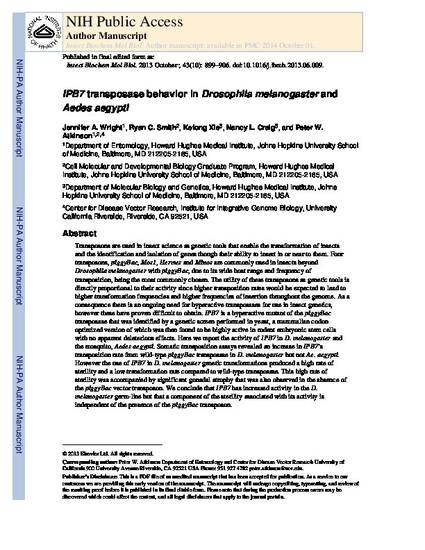
Article
IPB7 transposase behavior in Drosophila melanogaster and Aedes aegypti
Insect Biochemistry and Molecular Biology
(2013)
Abstract
Transposons are used in insect science as genetic tools that enable the transformation of insects and the identification and isolation of genes though their ability to insert in or near to them. Four transposons, piggyBac, Mos1, Hermes and Minos are commonly used in insects beyond Drosophila melanogaster with piggyBac, due to its wide host range and frequency of transposition, being the most commonly chosen. The utility of these transposons as genetic tools is directly proportional to their activity since higher transposition rates would be expected to lead to higher transformation frequencies and higher frequencies of insertion throughout the genome. As a consequence there is an ongoing need for hyperactive transposases for use in insect genetics, however these have proven difficult to obtain. IPB7is a hyperactive mutant of the piggyBac transposase that was identified by a genetic screen performed in yeast, a mammalian codon optimized version of which was then found to be highly active in rodent embryonic stem cells with no apparent deleterious effects. Here we report the activity of IPB7 in D. melanogaster and the mosquito, Aedes aegypti. Somatic transposition assays revealed an increase in IPB7's transposition rate from wild-type piggyBac transposase in D. melanogaster but not Ae. aegypti. However the use of IPB7 in D. melanogaster genetic transformations produced a high rate of sterility and a low transformation rate compared to wild-type transposase. This high rate of sterility was accompanied by significant gonadal atrophy that was also observed in the absence of the piggyBac vector transposon. We conclude that IPB7 has increased activity in the D. melanogaster germ-line but that a component of the sterility associated with its activity is independent of the presence of the piggyBac transposon.
Disciplines
Publication Date
2013
DOI
10.1016/j.ibmb.2013.06.009
Publisher Statement
This is a manuscript published as Wright, Jennifer A., Ryan C. Smith, Xianghong Li, Nancy L. Craig, and Peter W. Atkinson. "IPB7 transposase behavior in Drosophila melanogaster and Aedes aegypti." Insect biochemistry and molecular biology 43, no. 10 (2013): 899-906.
Citation Information
Jennifer A. Wright, Ryan C. Smith, Xianghong Li, Nancy L. Craig, et al.. "IPB7 transposase behavior in Drosophila melanogaster and Aedes aegypti" Insect Biochemistry and Molecular Biology Vol. 43 Iss. 10 (2013) p. 899 - 906 Available at: http://works.bepress.com/ryan_smith1/16/
Creative Commons license

This work is licensed under a Creative Commons CC_BY-NC-ND International License.
